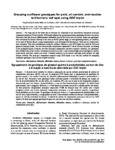Por favor, use este identificador para citar o enlazar este ítem:
http://www.alice.cnptia.embrapa.br/alice/handle/doc/1022845Registro completo de metadatos
| Campo DC | Valor | Lengua/Idioma |
|---|---|---|
| dc.contributor.author | LEITE, R. M. V. B. de C. | pt_BR |
| dc.contributor.author | OLIVEIRA, M. C. N. de | pt_BR |
| dc.date.accessioned | 2015-08-27T11:11:11Z | pt_BR |
| dc.date.available | 2015-08-27T11:11:11Z | pt_BR |
| dc.date.created | 2015-08-27 | pt_BR |
| dc.date.issued | 2015 | pt_BR |
| dc.identifier.citation | Pesquisa Agropecuária Brasileira, Brasília, DF, v. 50, n. 8, p. 649-657, ago. 2015. | pt_BR |
| dc.identifier.uri | http://www.alice.cnptia.embrapa.br/alice/handle/doc/1022845 | pt_BR |
| dc.description | ABSTRACT: Abstract ‒ The objective of this work was to evaluate the suitability of the multivariate method of principal component analysis (PCA) using the GGE biplot software for grouping sunflower genotypes for their reaction to Alternaria leaf spot disease (Alternariaster helianthi), and for their yield and oil content. Sixty‑nine genotypes were evaluated for disease severity in the field, at the R3 growth stage, in seven growing seasons, in Londrina, in the state of Paraná, Brazil, using a diagrammatic scale developed for this disease. Yield and oil content were also evaluated. Data were standardized using the software Statistica, and GGE biplot was used for PCA and graphical display of data. The first two principal components explained 77.9% of the total variation. According to the polygonal biplot using the first two principal components and three response variables, the genotypes were divided into seven sectors. Genotypes located on sectors 1 and 2 showed high yield and high oil content, respectively, and those located on sector 7 showed tolerance to the disease and high yield, despite the high disease severity. The principal component analysis using GGE biplot is an efficient method for grouping sunflower genotypes based on the studied variables. RESUMO: O objetivo deste trabalho foi avaliar a adequação do uso do método multivariado de análise de componentes principais (ACP), com uso do programa GGE biplot, para o agrupamento de genótipos de girassol quanto à sua reação à mancha de alternária (Alternariaster helianthi), e quanto à produtividade e ao teor de óleo. Sessenta e nove genótipos foram avaliados quanto à severidade da doença em campo, na fase de desenvolvimento R3, em sete safras, em Londrina, PR, com uso de uma escala diagramática própria, desenvolvida para esta doença. A produtividade e o teor de óleo também foram avaliados. Os dados foram padronizados com o programa Statistica, e o GGE biplot foi utilizado para ACP e exibição gráfica dos dados. Os dois primeiros componentes principais explicaram 77,9% da variação total. De acordo com o biplot poligonal, obtido com os dois primeiros componentes principais e as três variáveis resposta, os genótipos foram divididos em sete setores. Os genótipos alocados nos setores 1 e 2 apresentaram alta produtividade e alto teor de óleo, respectivamente, e os agrupados no setor 7 apresentaram tolerância à doença e alta produtividade, apesar de elevada severidade da doença. O método de análise de componentes principais com uso do GGE biplot é eficiente para agrupar genótipos de girassol com base nas variáveis estudadas. | pt_BR |
| dc.language.iso | por | pt_BR |
| dc.rights | openAccess | pt_BR |
| dc.title | Grouping sunflower genotypes for yield, oil content, and reaction to Alternaria leaf spot using GGE biplot. | pt_BR |
| dc.type | Artigo de periódico | pt_BR |
| dc.date.updated | 2017-06-20T11:11:11Z | pt_BR |
| dc.subject.thesagro | Girassol | pt_BR |
| dc.subject.thesagro | Doença de planta | pt_BR |
| dc.subject.thesagro | Helianthus Annuus | pt_BR |
| dc.subject.nalthesaurus | Plant diseases and disorders | pt_BR |
| riaa.ainfo.id | 1022845 | pt_BR |
| riaa.ainfo.lastupdate | 2017-06-20 | pt_BR |
| dc.identifier.doi | 10.1590/S0100-204X2015000800003 | pt_BR |
| dc.contributor.institution | REGINA MARIA VILLAS BOAS DE CAMPOS LEITE, CNPSO; MARIA CRISTINA NEVES DE OLIVEIRA, CNPSO. | pt_BR |
| Aparece en las colecciones: | Artigo em periódico indexado (CNPSO)  | |
Ficheros en este ítem:
| Fichero | Descripción | Tamaño | Formato | |
|---|---|---|---|---|
| ArtigoPAB50n08a03.pdf | 529,56 kB | Adobe PDF |  Visualizar/Abrir |









